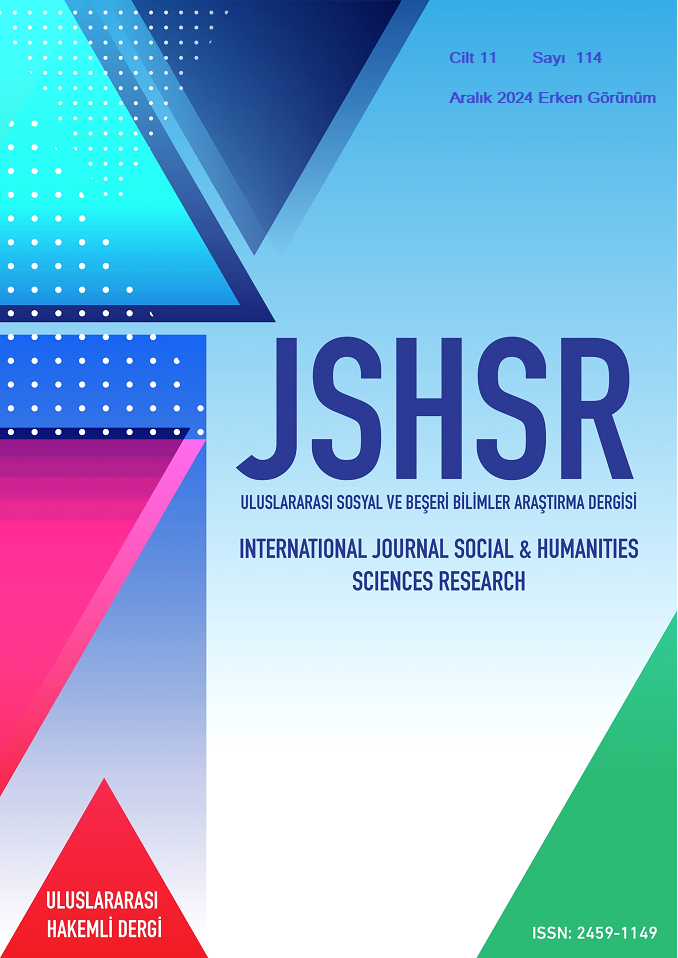An Analysis of Johannes Brahms's Intermezzo Op. 118 No. 2
DOI:
https://doi.org/10.5281/zenodo.14579791Keywords:
Johannes Brahms, Intermezzo Op. 118 No. 2, Romantic Period, piano performance, musical analysisAbstract
This research aims to analyze Johannes Brahms's piano work Intermezzo Op. 118 No. 2 in terms of musical analysis and performance techniques. As one of the significant examples of Brahms's integration of classical form with profound lyrical expression, the piece embodies the distinctive stylistic features of the late Romantic period. The study employs a descriptive research method and content analysis to evaluate the piece's formal structure, thematic development, harmony, and characteristic Romantic elements in detail.
The findings reveal that the piece is adorned with harmonic colors and cadences featuring delayed resolutions, reflecting the emotional intensity of the Romantic era. Simultaneously, its thematic layers and contrapuntal texture exhibit classical coherence. From a technical perspective, the piece's wide-spaced chords, bass movements, and varied dynamic transitions require the performer to develop exceptional sensitivity in pedal usage and nuance control. The study addresses key aspects such as pedaling, articulation, and tempo in the performance of Intermezzo Op. 118 No. 2, offering recommendations for crafting an interpretation aligned with the cantabile style of the Romantic period. As a perfect example of Brahms's mature style, the work holds significant value in the repertoire both technically and artistically. This research aims to contribute to a comprehensive musicological and pedagogical guide for Intermezzo Op. 118 No. 2, enhancing its understanding and interpretation.
References
Akdeniz, A. Ö., & Artaç, A. (2023). Konservatuvar eğitiminde Brahms’ın op. 108 re minör keman-piyano sonatının, bestecinin müzikal stil ve çalış teknikleri açısından incelenmesi ve öneriler. Rast Müzikoloji Dergisi, 11(2), 263-288.
Alpay, T. Ö. (2010). Romantik dönemde varyasyon ve Johannes Brahms’ın solo piyano için varyasyonları (Yayımlanmamış Sanatta Yeterlik Tezi). Dokuz Eylül Üniversitesi.
Arslanboğa, M. (2010). Johannes Brahms’ın viyolonsel – piyano sonatlarının müzikal analizi (Yayımlanmamış Yüksek Lisans Tezi). Erciyes Üniversitesi.
Babuççu, A. H. (2024). Erken Alman Romantiklerinde felsefenin bir imkânı olarak sanat ve edebiyat. Kaygı: Bursa Uludağ Üniversitesi Fen-Edebiyat Fakültesi Felsefe Dergisi, 23(2), 415-448.
Bali, S. (2018). Müzikte romantik dönem bestecileri. Vakıfbank Kültür Yayınları.
Crutcher, N. C. A. (2019). Defining the late style of Johannes Brahms: A study of the late songs (Unpublished Doctoral dissertation). West Virginia University.
Çepni, S. (2021). Proje, tez ve araştırma makalelerinin kavramsal ve kuramsal çerçevesi nasıl yapılandırılmalı? Fen Matematik Girişimcilik ve Teknoloji Eğitimi Dergisi, 4(3), 203-216.
Çoşkuner, Ö. (2021). Johannes Brahms’ın op. 4 sayılı scherzo’sunun teknik açıdan incelenmesi ve öneriler. SED-Sanat Eğitimi Dergisi, 9(2), 117-127.
Desai, B. (2003). The boy Brahms. 19th-Century Music, 27(2), 132-136.
Göktepe, M. (2020). Romantizm sanat akımı ve sanatçıları üzerine bir değerlendirme. Journal of Arts, 3(1), 45-66.
Greenberg, R. (2002). Great masters: Brahms-his life and music. San Francisco: The Teaching Company Limited Partnership.
İlyasoğlu, E. (2001). Zaman içinde müzik. İstanbul: Yapı Kredi Yayınları.
Kahraman, B. (2022). Johannes Brahms’ın op. 118 altı piyano parçası'nın armoni, form ve stil açısından incelenmesi (Yayımlanmamış Yüksek Lisans Tezi). Mimar Sinan Güzel Sanatlar Üniversitesi.
Karadut, A. (2012). Oda müziği sonatı besteleme geleneğinde J. Brahms viyolonsel-piyano sonatları. Sanat ve Tasarım Dergisi, 3(3), 60-76.
Karasar, N. (2012). Bilimsel araştırma yöntemleri. Ankara: Nobel Yayın Dağıtım.
Kaygısız, M. (2009). Müzik tarihi. İstanbul: Kaynak Yayınları.
Kravchuk, M. (2024). Brahms: Intermezzo Op. 118 No. 2. Michael Kravchuk Music.
Kutluk, F. (1997). Müziğin tarihsel evrimi. İstanbul: Çivi Yayınları.
Mimaroğlu, İ. (1999). Müzik tarihi. İstanbul: Varlık Yayınları.
Rosenblum, S. P. (1993). Pedaling the piano: A brief survey from the eighteenth century to the present. Performance Practice Review, 6(2), 158-180.
Say, A. (2019). Müzik tarihi. İstanbul: Islık Yayınları.
Schwartz, W. H. (2018). The story of musical instruments. Creative Media Partners, LLC.
Selanik, C. (1996). Müzik sanatının tarihsel serüveni. Ankara: Doruk Yayıncılık.
Siepmann, J. (2002). Life and works: Johannes Brahms. Londra: Naxos.
Soares, D. A., & Monteiro, E. (2024). Técnica de oitavas na Sonata op. 2 de Brahms: revisão bibliográfica e aplicação prática. ABRAPEM, 1(2), 69–74.
Şentürk, R. S. (2019). Johannes Brahms 51 piyano egzersizi. Conservatorium, 6(2), 169-186.
Yıldırım, A., & Şimşek, H. (2011). Sosyal bilimlerde nitel araştırma yöntemleri. Ankara: Seçkin Yayıncılık.
Yıldırım, K. (2024). Romantik dönem keman eserlerinin müzik öğretmenliği lisans programlarında kullanılabilirlik durumuna ilişkin öğretim elemanı görüşleri (Yayımlanmamış Yüksek Lisans Tezi). Sivas Cumhuriyet Üniversitesi.
Zhou, T. (2021). Brahms as a nationalist inherited from the tradition of German-Austria. International Journal of Frontiers in Sociology, 3(5), 82-84.
Downloads
Published
How to Cite
Issue
Section
License
Copyright (c) 2024 INTERNATIONAL JOURNAL OF SOCIAL HUMANITIES SCIENCES RESEARCH

This work is licensed under a Creative Commons Attribution 4.0 International License.


